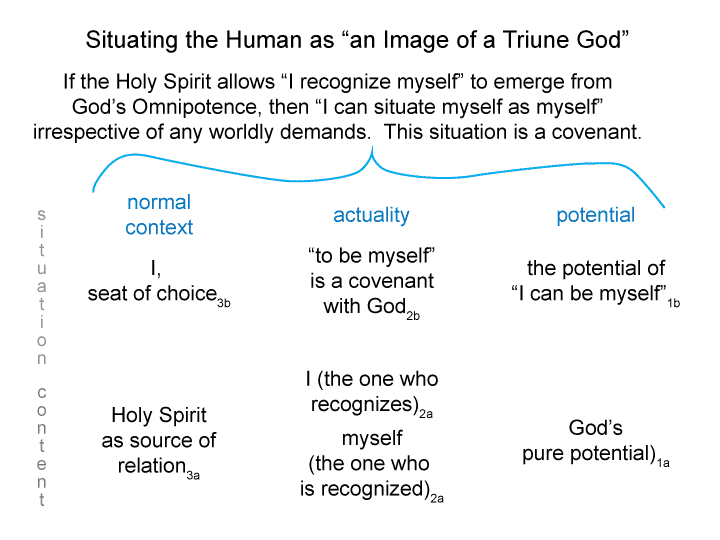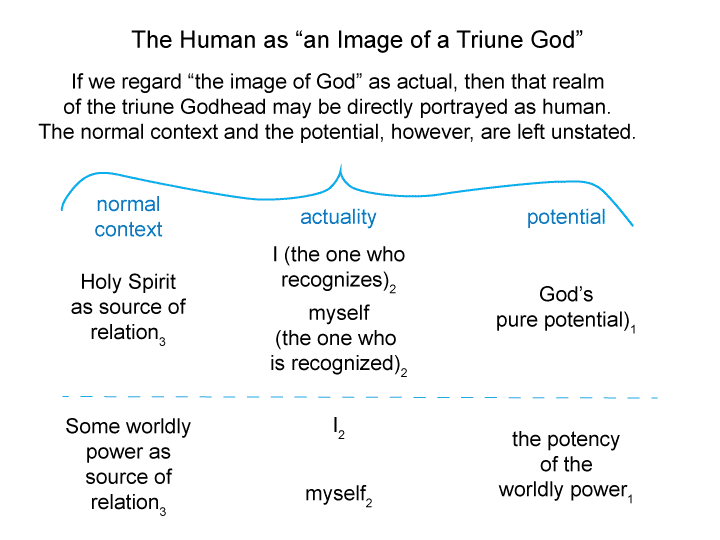Man and Sin by Piet Schoonenberg (1964) 2.1BF
Summary of text [comment] page 67
[What is a covenant?
A covenant is a deal: If you do this, I will do that.
So far, for “the human created in the image of God”, the covenant is:
IF I2 recognize “God3 as the one1 who created me2 in His own image1“,
THEN “I2 can recognize myself2 as who I am1”.]
Man and Sin by Piet Schoonenberg (1964) 2.1BE
[“The Holy Spirit3” brings “I (the one who recognizes myself) and myself (as the one who I recognize)2” into relation with “the Omnipotence of God1“.
This relation constitutes a covenant.]
Man and Sin by Piet Schoonenberg (1964) 2.1BD
Summary of text [comment] page 67
[Is there some advantage to admitting that God brought me out of His own pure potential?
The advantage is that I am free to be myself.
IF God brought me forth according to His Omnipotence,
THEN I emerge from the realm of possibility without qualification.
Thus, I can see, in myself, the likenesses of both the Father and the Son.
At the same time, I am obligated to acknowledge “the context (of His Creation)3” as well as “the image of the Omnipotence of God1“, in which I find myself.]
Man and Sin by Piet Schoonenberg (1964) 2.1BB
[So, I wonder, what normal context could bring I (the one who recognizes) and myself (the one who is recognized) out of the realm of possibility?
I must admit that “it was never inevitable that I exist”.
So either, “‘God3‘ brought ‘I and myself2‘ into relation with ‘His pure potential1‘.” or “It was pure luck” or “It was destiny” or whatever …
The former option is the apparently discredited concept of design. The latter options are completely crazy.
So, which do I choose, discredited sanity or creditable craziness?]
Man and Sin by Piet Schoonenberg (1964) 2.1BA
[I cannot proclaim: I am my own relation.
Despite this, the proclamation holds an odd attraction. The idea sounds like “what a Pharaoh might say”:
“I3” brought “I and myself2” into relation with “the potential inherent in me1“.
Yes, it sounds like Pharaoh.
But it also sounds like sin.
Why?
Well, look at the normal context.
Sounds presumptive, no? It sounds like “me, me, me.”.
Also, look at the realm of possibility.
Sinners destroy themselves by imagining that they are omnipotent. Or perhaps, they regard themselves as so exceptional that there is no possibility of failure. The rules do not apply to them.]
Man and Sin by Piet Schoonenberg (1964) 2.1BA
[I recognize me.
Yeah, that would image “God Recognizes Himself”.
“I” would be the image of “the One Who Recognizes” and “myself” would be the image of “the One Who Is Recognized”.
What could be the catch?
The match only works in the realm of actuality.
In thirdness, I cannot image my own relation to myself.
I cannot proclaim: I am my own relation.
Why?
I am not omnipotent.]
Man and Sin by Piet Schoonenberg (1964) 2.1AZ
[Well, let’s start with this apparently straightforward question:
Is “I recognize myself” an image of “God Recognizing Himself”?
If yes, then how would this work?
It seems obvious.
“I” would be the image of “the One who Recognizes” and “myself” would be the image of “the One who Is Recognized”.]
Man and Sin by Piet Schoonenberg (1964) 2.1AY
Summary of text [comment] page 67
[So let me consider how “an image of God” would fit into a nested form.
There are clearly three slots in God Recognizing Himself:
(3) God (the Holy Spirit) belongs to triadic relations.
(2) “What God Recognizes” (the Son) and “God Recognizing” (the Father), both belong to actuality.
(1) Omnipotence (the capacity to Recognize and Be Recognized) belongs to the realm of possibility.]


